CADOXTON OPERA
Martyn J Griffiths
TRAVELLING OPERA
Neath town at the start of the nineteenth century was a small, compact area centred on St. Thomas’ Church and numbering about 2,500 souls. By the time of the 1851 census, this number had more than doubled and was to double again over the following thirty years. Expansion came with industry, but with industry there also came all the attendant businesses; people had to be fed, had to drink ale, had to buy clothes and had to be entertained.
What was life really like in Victorian Neath? Was it work, work, work or did people have time to relax and enjoy life. We know that most people worked long hours for six days a week, usually with a day off on Sunday so that they could attend church or chapel. Perhaps surprisingly there were many opportunities to take part in various sporting activities, listen to concerts and Penny Readings or to join a choir or even to go to the theatre or opera.
There was no local opera in Neath in the nineteenth century, indeed, there was very little theatre of any kind. The building of a new town hall in 1820 might have heralded a change but, initially, there was no stage and, therefore, nowhere in the town where theatrical performances with numerous participants could take place[1].
This did not mean that the town was not privy to entertainment, as this was provided by the small touring theatres that visited the fairs and markets; their performances also including opera.
From the middle of the century, the town was treated every few years to a visit by one of a number of travelling opera companies. No doubt the development of railways had a great influence on the availability of these performances. Some of these touring companies barely survived and their operas were performed on a very restricted budget. One report lauded the Horace Lingard Comic Opera Company on their production, ‘Falka’, at the Assembly Rooms in Neath but added that it would have been complete if there had been an orchestra (the only accompaniment was by means of a piano). The audience which invariably gathered at the Town Hall was usually described as ‘respectable’ inferring that it was not all walks of society that enjoyed the delights of opera. Perhaps, as today, cost was an issue with tickets for a concert in 1854 on sale at two shillings and six pence, children a shilling less. One notice stated ‘children in arms not admitted’. The Cambrian reporter also had his doubts about the suitability of opera for the Neath public, commenting on the sold-out performance of Faust by the London Opera Company in 1866, but nevertheless stating that the opera was ‘not sufficiently interesting for a Neath audience.’ The Lyric Opera & Burlesque Company was another popular touring group, appearing in Neath several times between 1863 and 1871.
This excerpt from a Merthyr newspaper of 1863 gives some idea of the effect of opera on the masses which might equally have been referring to the town of Neath where, on at least one occasion, people were turned away because the hall was full:
First we had a rambling theatrical company, who by their pieces and acting catered to the lowest of the people and the lowest of tastes, and sentiments; and secondly, concerts which gave the most unambitious of productions ... The last noticeable innovation is the Lyric Opera Company. Who could have imagined a short time ago that a 'gallery class' of a Merthyr audience could be found to enjoy this luxury? They were supposed to suit only higher palates; but, night after night, we have seen the gallery applauding most heartily some of the first operatic pieces. These things should teach a lesson to those who are left, now and then, to cater to the popular relish for amusement. Bring talent here of unquestionable soundness, and an audience will be found sufficiently large to make the introduction remunerative.... The townspeople are very advanced in the theory and practice of music.[2]
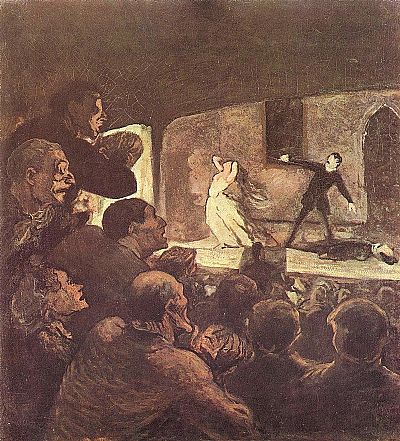
Victorian Opera Wikipedia
At Neath companies would perform for a few days, usually at the Town Hall or Robinson’s Assembly Rooms and also later at the new Gwyn Hall. These performances would not have been the large choral masterpieces that one can see today; touring the provinces they were confined by the size of the stage and when the English Opera and Burlesque Company visited the town in June 1870 they had just twelve artistes. The Welsh Opera, based in Cardiff, toured in September 1890 and visited Neath performing Joseph Parry’s ‘Arianwen’ in the Gwyn Hall on Thursday and Friday evenings with tickets priced from three shillings down to six pence. Room for everyone. The chorus was just a dozen voices, augmented in larger towns by local choristers.
Dr Parry’s ‘Blodwen’ was performed in Alderman Davies’ School, July 1878, to what was termed a ‘numerous and fashionable audience.’
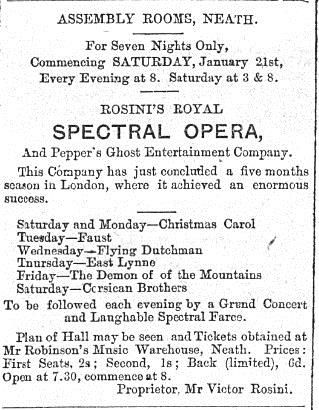
Bridgend Chronicle - 20th January 1893
A touring opera visits Neath Assembly Rooms
AMATEUR OPERA
The Cadoxton Amateur Operatic Society (CAOS) was formed in 1908[3] and the first production is said to have been a rendering of ‘Good Queen Bess’ [4] in the vicarage barn in the village although full details have been lost along the years. Alfred Jones and David John Lewis were the founders of The Cadoxton Male Voice Party, as the society was then named. The first known opera performance by the society was Maritana by the Irish composer, William Vincent Wallace, which had premiered over seventy years earlier. That was in 1911 and it was followed by Rose of Castile in 1912. With war imminent, productions ceased and it was nine years later that the society re-started. The society thereafter produced an opera almost every year, apart from another long gap around the time of the Second World War.
The Musical Director and Producer for many decades was local man Alfred Jones. He was Head Clerk at the Cadoxton Brewery and later became a coal merchant. He was choir-master at St. Catwg’s Church, Cadoxton and it is likely that he included many of the church choir in his new venture, but it was the Cadoxton Male Voice Choir that formed its backbone, Jones is said to have been a self-taught musician and he obviously had a lot of natural talent as he remained in charge until near his death in 1959. He was an exacting taskmaster with an attention to minute detail which, no doubt, could be infuriating, but which made the performance all the more professional. Later musical directors would be paid, but Alfred Jones would never accept any money.
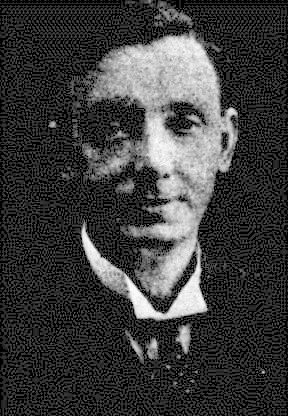
Neath Guardian
Alfred Jones
His co-founder, David John Lewis, served for a long time as Chairman. He was employed as a moulder in a brass foundry. He became best known as Tower Captain of the St. Catwg’s Guild of Bellringers.[5]
The lead singers at this time were all local village talent or at least talent from the Neath area, Thomas Williams (bass), Henry McNeill (tenor) from Skewen and Hilda Davies (soprano) were the soloists in many operas and concerts.
The creation of the Neath Amateur Operatic Society in 1911 might have proved a problem, but this did not create any sort of competition, as they concentrated mainly on Gilbert & Sullivan light operettas. There were many other operatic societies around Neath in the years that followed, such as Resolven, Briton Ferry and Melyncryddan, but none of them competed with Cadoxton since they again concentrated their efforts on light operettas and musicals.
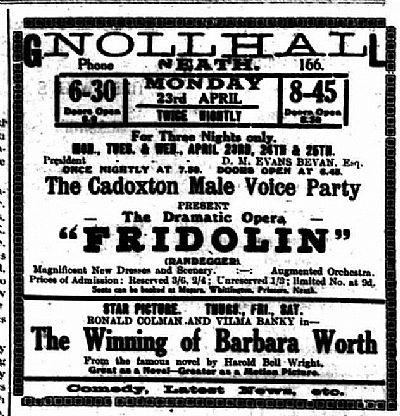
Neath Guardian - 29th April 1928
This advertisement shows the Society's origins with the Cadoxton Male Voice Party
The Great Depression (1929-1939) was a bad time for any form of entertainment, be it musical, theatrical or sporting. People just did not have the disposable income. In August 1929 it was announced that the Cadoxton Amateur Operatic Society was defunct. Just five months later it was back with a new chairman and committee, struggling on in difficult times and presenting the ever-popular Carmen. One particularly testing opera performed by them was Wagner’s Tannhauser. This was the only time they attempted Wagner whose works are known to be demanding even for professional singers.
Before World War Two the main singers were recruited from within the Society ranks. There were no professionals. Regular leads were Hilda Davies, Mary Parker, Elsa Mills, Roy Hocking, William Hickman and Basil Williams. Alfred Jones was a constant as musical director, whilst Drucilla Thomas (later Rees) was another ever-present as accompanist. She was the Society’s accompanist for over fifty years, from at least 1928 (as a twenty-year-old) to 1983, the year she passed away. The Morgan Lloyd Orchestra of Swansea joined them in 1934 and stayed for forty years. The Society was amateur in every way, but nevertheless strived for a professional performance. Sometimes they fell short, for example, in a 1920s production, the make-up of lead singer Henry McNeil, was described as grotesque and ‘spoiling his interpretation’, but they were learning – and improving – all the time.
1936 saw another first with Cadoxton essaying a double-bill withthe productions of carmen and La Traviata. Elsa Mills starred in the title role as Carmen whilst Madame Margaret Cox from Briton Ferry starred as Violetta in La Traviata. The night was an unqualified success which further advanced the Society's reputation. This exacting programme of two operas would not be repeated until 1966.
Romance was not confined to the stage. In 1935 two of the lead singers, Melville Johns, tenor, and soprano, Elsa Mills, were wed. They later joined the Neath Opera Group where Mr Johns was chairman. He also became chair of Neath Rugby Club.
Rehearsals took place in the school hall at Cadoxton, but in 1937 a new vicar, Rev. DW Rees, stopped the Society’s hire of the hall for no apparent reason and, after 25 years of using the premises, the Cadoxton Opera was homeless. It was particularly galling as charity concerts had been held for the church in the past. Other organisations continued to use the hall so this must have been a very contentious decision.
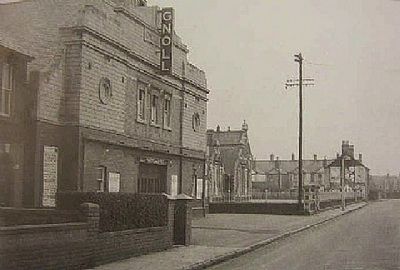
The Gnoll Hall - home of the Cadoxton Opera before the War
THE WAR AND BEYOND
Theatres across Britain were ordered to close on the outbreak of the Second World War but were subsequently allowed to re-open. Cadoxton Opera however did not resume its productions until 1951 although this did not prevent them putting on occasional concerts.
At least two of their number entertained troops during the War. Ivor Adams, a fine baritone, took part in concerts in France. He was part of a singing family. His brothers, Luther, Elwyn and Phillip were all well-known solo concert performers and choir members in Neath and so, later, was his niece, Vera Adams. Staff-sergeant Melville Johns did his entertaining in the Middle-East but he did so by recording several solos with the Royal Army Ordnance Corps in a series of programmes called ‘Bits and Pieces’ which were relayed to the troops in Cairo.
The Society resumed its activities early in 1944, with a concert in Cadoxton school, but the revival was short-lived and it was not until 1950 that they began preparing once again for a full-scale opera. A social evening welcomed back many old faces but there were plenty of newcomers also to swell the ranks. The venue for La Traviata in April 1951 changed from the old Gnoll Hall to the Gwyn Hall. Margaret Cox returned in the starring role but shared the lead with Elsie Dennis Davies on alternate nights. Alfred Jones as musical director and producer and the Morgan Lloyd orchestra were also amongst those returning. As always, the newspaper critiques whilst lauding the efforts of those taking part, also highlighted their deficiencies. Perhaps, the reporters were unfair in their comments which would have been based on comparisons with professional performances.
In 1953 Cadoxton produced Aida, considered to be the grandest of Grand Operas. In order to maximise the effects, the Society secretary wrote to the principal opera houses in Italy and many of them, including La Scala, Milan, replied with comments and photographs. The most productive assistance, however, was from a newspaper in Verona where operas are performed annually in a Roman amphitheatre.
It was not easy to find photographs of performances at the Amphitheatre, because we and the Ente Autonomo Spettacoli Lirici (the operatic performances establishment) had copies only in the City archives. However, we have been successful in photographing these and we are very glad to send them to you as a gift from the people of Verona.
Mary Parker, who had been taking lead roles before the War, was once again cast as lead soprano and was to continue as such for the Society in the years that followed. The production of Bellini’s I Puritani in 1954 was said to be the first time it had been seen in the UK outside of Covent Garden. The Cadoxton Society often put on rarely heard operas. Verdi’s Mephistopholes (1957) had only twice previously been heard in Britain and the Society had to send to Italy for the words and music and had to then transcribe the English words below the Italian ones. Milan even sent a set of photographs of the opera to help with stage sets and costume design. Later productions of Force of Destiny (1964), The Pearl Fishers (1966), Norma (1969) and Lucia di Lammermoor (1977). The Neath Guardian reported that this was the first time these operas had been performed in Wales.
The latest member of the Adams family, Vera, made her debut as Carmen in 1958, sharing the role on alternate nights with Glenys Dowdle of Morriston, another favourite of the Society.
Two former Alderman Davies pupils took over the production a year later when the twin operas Cavalleria Rusticana and I Pagliacci were performed. David G Davies had starred with the Society as a bass in their productions of Mephistopheles and L’Elisir d’Amore; whilst Dudley Hopkins had been involved with the Society management for the previous four years. Mr Hopkins was what one might call an opera fanatic. Whilst serving in Italy after the end of the War he saw about 120 operas in an eighteen-month period and subsequently paid annual visits to the Italian opera houses. His passion later led him to push through the refurbishment of the Adelina Patti theatre at Craig-y-nos and for it to be adopted by the Neath Opera Group for their annual performances. As well as Grand Opera, the Society also contributed to the occasional charity event.
In the mid-1950s Alfred Jones’ health began to fail and after nearly half a century as musical director and producer it was time to hand over the reins. He passed away in 1959.
The Society was never afraid to try operas that were rarely seen, but sometimes that led to poor audiences, as in 1961 when ‘The Bartered Bride’ was performed with much acclaim before a half empty house. The Society was noted as a kind of preparatory school for the Welsh National Opera with Glenys Dowdle and Anita Whitehouse (Marvin) securing lead parts there. The regular men in lead roles were Donald Griffiths of Bryncoch and Edward Plucknett from Morriston, whose baritone was compared to Paul Robeson. Plucknett, was a winner at the 1960 National Eisteddfod.
Guest appearances were becoming more diverse and more frequent. John Myrddin of Briton Ferry, dubbed ‘The Caruso of Wales,’ took a lead in 1964’s ‘A Force of Destiny’. He was a member of the Carl Rosa Opera Company. Anita Marvin (1965) sang with Sadler’s Wells and WNO whilst Gordon Whyte of Swansea (1968) was a member of the Welsh National Opera.
In September 1965 the whole Society departed for Waterford where they closed that city’s Festival of Light Opera with their rendition of Nabucco. The festival, which had been going for some years, took the form of a competition, but the Cadoxton group did not participate in that. It was the first time an overseas Society had presented grand opera and Cadoxton’s Nabucco, with Clive John from Morriston as Musical Director, proved a tremendous success. The local press hailed the chorus as ‘the best heard in Waterford. The lead tenor was Allun Davies. Earlier that year he had won Opportunity Knocks, the television talent programme run by Hughie Green, winning the public vote for seven continuous weeks. His success led to him being mobbed in the street at the Home & Colonial store in Neath. Suddenly he was very much in demand and, in fact, he could not join the company when it left Wales for the Emerald Isle, but had to be flown over later. He had joined Cadoxton Opera at 14 years of age and first sang leads with them in the 1965 production of Nabucco. He returned to the same role in 1970 and in 1983. By the time that he was 16 he had already joined the chorus of the Welsh National Opera.
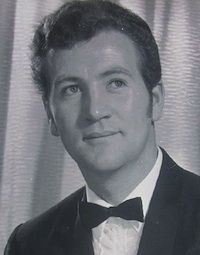
Allun Davies
The success of their visit led to the Society putting on a repeat performance of Nabucco in Neath the following year, alongside their scheduled production of The Pearl Fishers. It also led to them being asked back to Ireland again in 1983. These trips abroad were greatly looked forward to and even the sometimes rough passage across the Irish Sea could not dampen the many celebrations afterwards.
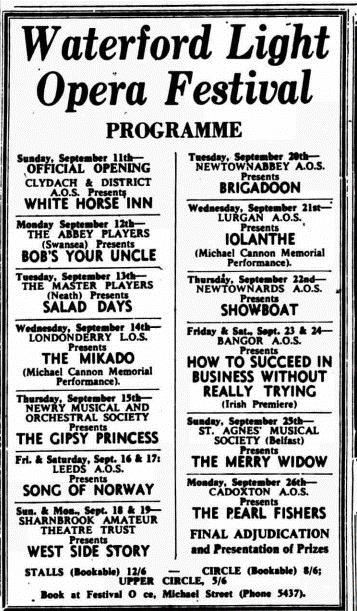
Cadoxton Opera's second appearance at Waterford
The ‘amateur’ opera company took on a more serious note after 1967 when the chorus of the Welsh National Opera Company became wholly professional. This change led directly to an influx of new members at Cadoxton as they no longer wished to belong to a professional chorus. Members joined from as far afield as the Gower, Pontypridd, Porthcawl, Pontardulais and Port Talbot. This resulted in the Society dropping the term ‘amateur’ from its title and from that time on being known simply as Cadoxton Opera Society.
The 1971 production of Samson and Delilah was a wonderful success story for the back-room staff who had to build a temple that would collapse on stage. The small team of Dr and Mrs Norman Thomas, Lyn Brown, Bert Jay and Fred Butler worked tirelessly to ensure that the scenery was properly erected and no unexpected accidents resulted from the inevitable collapse. The cast was aided by the cameo appearance of one of Wales’ premier opera stars, Briton Ferry born bass baritone Bruce Dargavel.
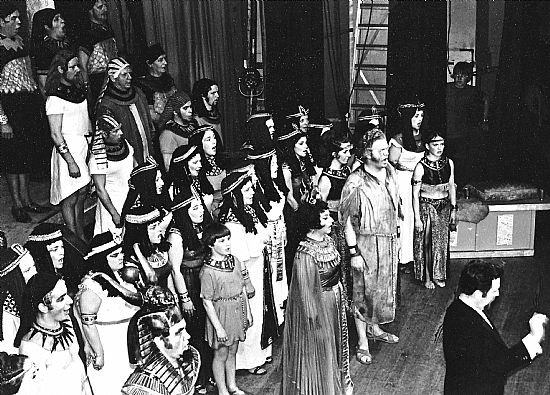
photo: Malcolm Rees
Kenneth Woodall and Margaret Willams lead the cast in Samson & Delilah at the Gwyn Hall 1971
Over the years rehearsals took part in many different venues, but in the 1970s and 1980s the Gnoll School was ‘home’, With demolition of the school imminent, the Society started a tour of Neath, utilising facilities at the Constitutional Club, Moose Hall, Gwyn Hall, and Old Town Hall before finally finding a permanent place at St. Catherine’s church hall in the Melin. Rehearsals took place on Tuesday evenings and continued until two weeks before the show when the professional ‘stars’ would join the company.
The Gwyn Hall was a popular venue for many societies and the Cadoxton Amateurs would book their late April slot years in advance. Preparation of the scenery would have started months in before by a very talented and dedicated crew and the sets would be transferred to the hall where, as if by magic, they would transform the scenery into a spectacular compliment to the performance.
Alan James, a teacher in Cynfig Comprehensice School, was the musical director throughout most of the seventies. It was a period which saw more professional singers being brought in for the lead roles. Behind the scenes it would be organised chaos in the cramped quarters of the Gwyn Hall.
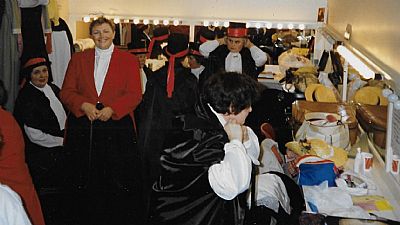
photo: Rhoda Daniels
A dressing room at the Gwyn Hall for Faust 1991
From Left: Val Nagy, Rhoda Daniels (in red jacket), Avril Godding, Mary Jenkin, Lillian Bear,Linda Rosser Lewis, Evelyn White ( hands on her hat) and Cath Pitt
There were many others, apart from the singers, who played their part in producing a spectacle. You had the stage managers and crew, lighting experts, hair dressers, wardrobe and of course front of house. You also had a group of dancers at most operas and these came from various parts of West Glamorgan, all indispensable. Running the shows were the Musical Director and Producer, whilst on the night an orchestra was brought in. Costumes were often produced by the Society members, especially when the budget was tight, but mostly they were supplied by outside bodies such as the Marigold Theatrical Costumiers of Brynmawr, Welsh National Opera, Haslemere Wardrobe, Bristol Old Vic and others.
Numbers in the chorus varied. Sometimes there were as many as 80 and other times around 40-50. One of the problems in the later years of the Society was a dearth of young male singers. This problem was eased for a few years when the Dunraven Barber Shop Choir joined the chorus. This group was from Cwmgwrach and although opera was a hugely different style, they fitted in very well to the Society demands.
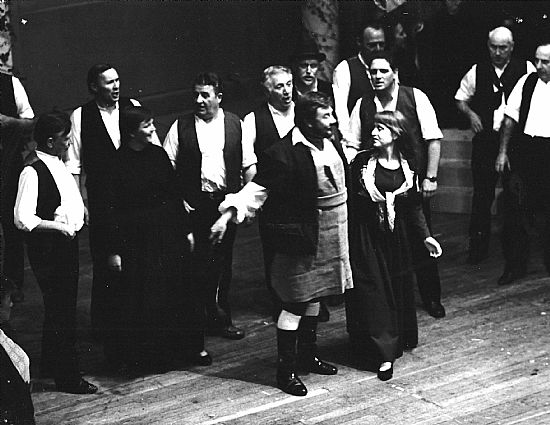
photo: Rhoda Daniels
No shortage of men in 1984 for Cavalliera Rusticana. Left-right Cliff Thomas, Mervyn Evans, Rhoda Daniels, Cynlais Hughes, John Church, David Jones, Michael Hutchings, Len Dennis and David J. Williams. In front are Terence Sharp and Phillipa Smith

photo: Rhoda Daniels
The ladies wait in the wings to go on stage for Ernani 1997
The stars of the show were professionals – too many to name them all, but mezzo soprano Beverley Humphreys was a particular favourite, making her debut as Carmen in 1980 and returning in 1984, 1985, 1986 and 1988. Another was soprano Anita Marvin, the mother of comedian, Paul Whitehouse. She first appeared in the 1961 production The Bartered Bride and returned in the title role in Norma, performed in 1969. Her last visit was in 1972 as an Egyptian princess in Aida.
There were many rising stars who performed for the Society including Jason Howard (1987), Jennifer Rhys Davis (1985 and 1986), Sian Cothi Morgan (1996),Bonaventura Bottone (1974) and others. Minor parts were taken by members of the chorus but they had to audition.
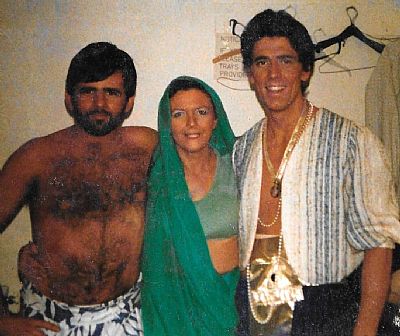
photo: Rhoda Daniels
The Pearl Fishers 1987
Baritone Jason Howard (right) with Huw Priday and Rhoda Daniels
Musical Directors had star billing and, after the demise of Alfred Jones, were paid for their services. Local men who worked with the Cadoxton Company were Alan M James (1973-81), Anthony Randall (1982), Christopher Jones (1983-8), Jason Shute (1990-1) and John Jenkins (1994). The other essential person for the rehearsal and production of a successful opera, was the producer. Cadoxton was fortunate in having the services of Paul Chandler from 1979 through to 1998.
Funding was always a problem with some productions costing as much as £10,000. A long list of Patrons and Vice-Presidents helped and the Society also received local sponsorship and grants from The Welsh Music Federation and The West Wales Federation for the Arts. In 1979 Sir Geraint Evans was listed amongst the Vice-Presidents. Ticket sales varied each year but the help of Betty Morgan of Cadoxton Post Office and Minnie Colwill who had a florist’s stall next door to the Gwyn Hall, was invaluable in this respect.
Some special events were organised to raise funds. An evening of musical entertainment took place at the Gwyn Hall in February 1983 with soloists Evelyn White from Port Talbot and baritone Nigel Hopkins, both Society members. A Gilbert and Sullivan concert was put on at Margam Orangery in July that year as part of the annual Margam Festival.
The Society was in desperate financial straits by 1985 and a Gala Concert was held in lieu of the annual opera with guest artistes for this essential fund-raising event, Jason Howard, Elizabeth Woollett and Huw Priday as well as Neath-born accompanist Phillip Thomas. Beverley Humphreys acted as compere. These stars of the show and long-time friends of Cadoxton Opera gave their services free of charge.
With dwindling ticket sales, rising costs and falling numbers of chorus members, the Society struggled in the late 1980s and in the 1990s. A couple of weeks before the 1989 production of the seldom heard Der Freischutz over two thousand tickets remained unsold and it was feared that it would be the Society’s final curtain. Financial difficulties led to the annual opera being abandoned in 1995 in favour of a concert to again raise funds. The Society was fortunate that strong friendships had been formed with some of the professional singers who came to their aid and made the concert something very special; the chorus in particular rose to the challenge and learned new works to compliment the professionals. During that year when finances began to be a concern, the members set about fund raising, from a cup of tea and a slice of cake 50p during rehearsal breaks, to a lavish garden party in the home of the Chair. This brought in much needed extra cash but ultimately it was not sufficient to sustain them.
Two performances had to be cancelled in the 1999 production of La Traviata, when the lead tenor, Huw Priday and the lead soprano, his wife Elizabeth Woollett, both contracted laryngitis. This obviously impacted on ticket receipts and cast more gloom on the Society’s financial position. The 2000 production of Nabucco was more of a concert piece and took place in St. David’s Church; a rare deviation from the usual venue at the Gwyn Hall. Perhaps this was a way of cutting the costs, but the decline was continuous and the following year’s production of Die Fledermaus was to be the last.
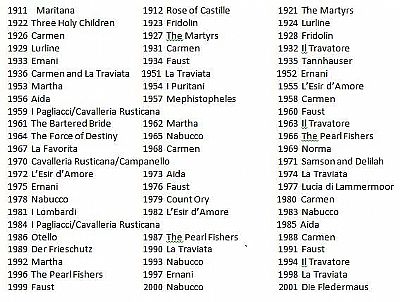
NOTE: One of the best aspects of the press coverage was that the Neath Guardian (up until the 1980s) often listed all those taking part, including the chorus; a tremendous asset for anyone wishing to look back at contributions made by family members.
OTHER SOURCES: Neath Guardian, Western Mail.
WITH THANKS – Rhoda Daniels, Margaret Hughes, Susan Roberts, Jean Wall, Malcolm Rees.
[1] NAST Vol. 6 1938 - Early Theatres at Neath… - John Smith

